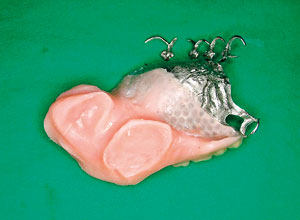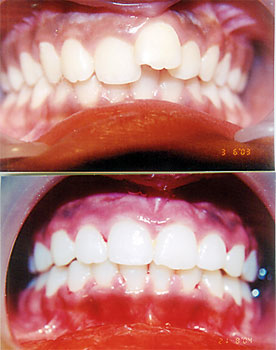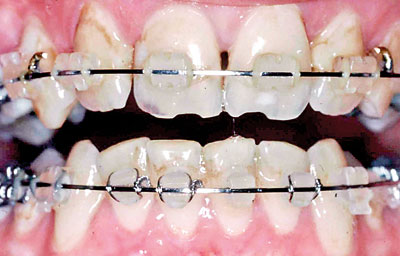Restorative dentistry — getting to the root
Recognised as a specialty in Sri Lanka since 1997, restorative dentistry is a comparatively young field in the country. However, experts say its uses and success rates have grown and will continue to grow in the future. Restorative dentistry is the science behind the restoration and reconstruction of teeth. Dr. Priyake Palipana, Consultant in Restorative Dentistry at the Institute of Oral Health in Maharagama, said the current trend is to preserve one’s own teeth until death, without extraction.

Prosthesis to cover a defect
“To a large extent, it is conservation that is important,” Dr. Palipana said. “All this time, for a minor cavity or pain, people were used to extracting teeth. Now the theme is to have one’s own teeth until death. But of course, you are likely to face a lot of problems along the way.”
Missing or damaged teeth can be the result of wear and tear, dental caries, trauma, cancer surgery or can even be a birth defect. Restorative dentistry also has cosmetic purposes in patients with disfigured or discoloured teeth. Dr. Palipana said patients are usually of all ages.
“In diagnosing the varying age groups, the main difference is that when diagnosing a young child, we think in terms of the next five or six decades and how he or she will use that tooth till then,” he said. Restorative dentistry has also proven miraculous in patients who have undergone surgery for oral cancer.
“Partial removal from the palate in cancer patients means we have to give them a prosthesis,” Dr. Palipana said. “Otherwise there will be regurgitation of food and liquids going into the nose. All these things could be easily prevented by means of a prosthesis known as obturators.”
There are several common methods of restoring or replacing teeth. Dental composite, the miracle material made of the organic substance resin, is used to replace or recontour teeth into their original normal shapes and sizes. Dentures, a set of false teeth, can also be prescribed. Dentures have been in use for many years. They need to be regularly removed and cleaned and are thus a more temporary solution.
Crowns and bridges are the other option, wherein crowns—tooth caps made of metal or porcelain—are held in place by bridges. This works when the damaged or missing tooth is between two healthy teeth, which hold the bridges in place. The most advanced technique is the tooth implant, where roots made of the metal Titanium and teeth made of porcelain are implanted during what doctors say is a simple operation. Titanium metal is used because it combines easily with real bone.
Dr. Palipana said government-run hospitals do not regularly perform tooth implants because they tend to be expensive. But while implants can be pricey, they are a permanent solution to missing teeth. These methods are accompanied by their fair share of drawbacks.
“Beneath crowns and bridges, cavities or dental caries may develop causing the bridges to be lost,” Dr. Palipana said. “Crowns and bridges also require some additional care to maintain good hygiene.” Implants are costly with prices ranging between Rs. 80,000 and Rs. 100,000 per tooth. Implants are not prescribed in patients with uncontrolled diabetes and uncontrolled advanced gum disease. Furthermore, smokers cannot undergo these operations.
“Smokers don’t heal easily and some of their cells are defective,” Dr. Palipana said. “Their implants usually fail.” Dr. Palipana stressed the importance of following the golden rule of brushing teeth regularly to prevent cavities, pointing out that prevention is better than cure.
“Furthermore, whatever defect you see in your teeth or gums, seek a dentist’s advice,” he said. “It is better to do something earlier than holding on until the disease advances. The cost of replacement is extremely high so early intervention is always better.”
Correcting the wrongs in your teeth and jaw
By Shaveen Jeewandara
In an age where looks matter more than they should, Orthodontics play a significant role in society. “The basics of orthodontics lie in the corrections of the jaws and malocclusions of the teeth (improper positioning of teeth when the mouth is closed),” says Consultant Orthodontist, Dr. Sriyani Basnayake. “It is a highly trained field and goes beyond dentistry,” she adds.
 |
 Correction through the use of braces and right, teeth before and after correction |
The two basic types of problems that are corrected by Orthodontics are jaw and teeth discrepancies, and these could vary from the slightest protrusion of a tooth, to a highly complicated cleft lip and palate reformation.
When it comes to jaw discrepancies, the most common problems lie in:
- The lower jaw being positioned in front of the upper jaw
- The lower jaw being placed far behind the upper
- Asymmetrical jaws
“Ideally, the lower jaw should be about two mm behind the upper jaw,” says Dr. Basnayake. Most of the corrections can be made by removable plate devices and braces (dubbed by many as ‘train-tracks), within the ages of 8-15 years.
However, severe cases may need to combine the use of surgery along with the devices for correction.
Teeth discrepancies arise from:
- Protruded teeth
- Spaced-out teeth;
- Impacted teeth
- Crowded teeth
- Rotated teeth.
- Missing teeth
- Extra teeth
“The removable or plate devices can only do a limited number of corrections, however you can do several types of tooth movements with the use of braces,” says Dr. Basnayake. “You can even move the root of teeth.”
The obvious difference between the two types of devices is the cost involved, as braces may cost up to five or six times more than the removable plates. “This is due to the material involved and the need for a specialized training required,” explains Dr. Basnayake. There is also a large degree of commitment on the part of the child when it comes to wearing removable plates, however with the fixed braces, this is not the question.
“Most of our work is cosmetic, as we try to make people look beautiful,” Dr. Basnayake mentions, adding that the degree of specialisation which Orthodontics runs into is far and wide. “There is a minimal margin of error when it comes to Orthodontics. When a tooth is moved, the bone is removed and replaced. These are highly specialised manoeuvres and thus should be done with extreme precision,” she adds.
Currently, there are only about 25 qualified orthodontists in Sri Lanka; There is, however, a large demand for teeth and jaw corrections, and Orthodontic units are present in approximately 15 general hospitals around the country.
Dr. Basnayake’s advice is to seek treatment for teeth and jaw problems from a qualified orthodontist, “the earlier the better. “Some corrections can be done at young ages; however some need to be done only when the child has reached a specific age. Some altogether need to be done once the growth of the child is done,” she says. “But we do not know which type of treatment the child would need, and therefore it is best to seek medical advice as soon as a malocclusion or irregularity in the teeth or jaw is identified.”
Follow @timesonlinelk
comments powered by Disqus


